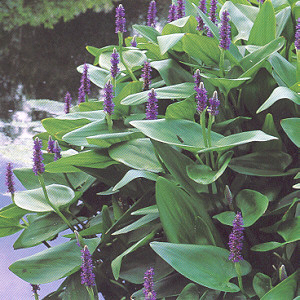Purple
Pickerelweed
Pontederia
cordata

Height:
18
- 24 in.
Width: Can
cover large areas.
Light: Sun
to part shade.
Soil: Any
good garden soil.
Blooms: Spring
to summer.
Propagation:
Divide clumps in spring while discarding
the rotting portions.
|
Pickerelweed
is a very common emersed plant. It is a prolific
grower and can cover large areas.
Pickerelweed
typically grows to about two to three feet tall.
Its leaves are shiny and deep green, and large,
up to five inches wide, and are usually twice as
long. Leaf shapes are variable, but are usually
lance-shaped. The easiest way to recognize Pickerelweed
is by its spike of violet-blue flowers. Sometimes
the flowers are white.
The
plant adapts well to shallow water to depths of
up to 18 in. Do not let crown freeze.
Hardy
zones 4-11.
|


